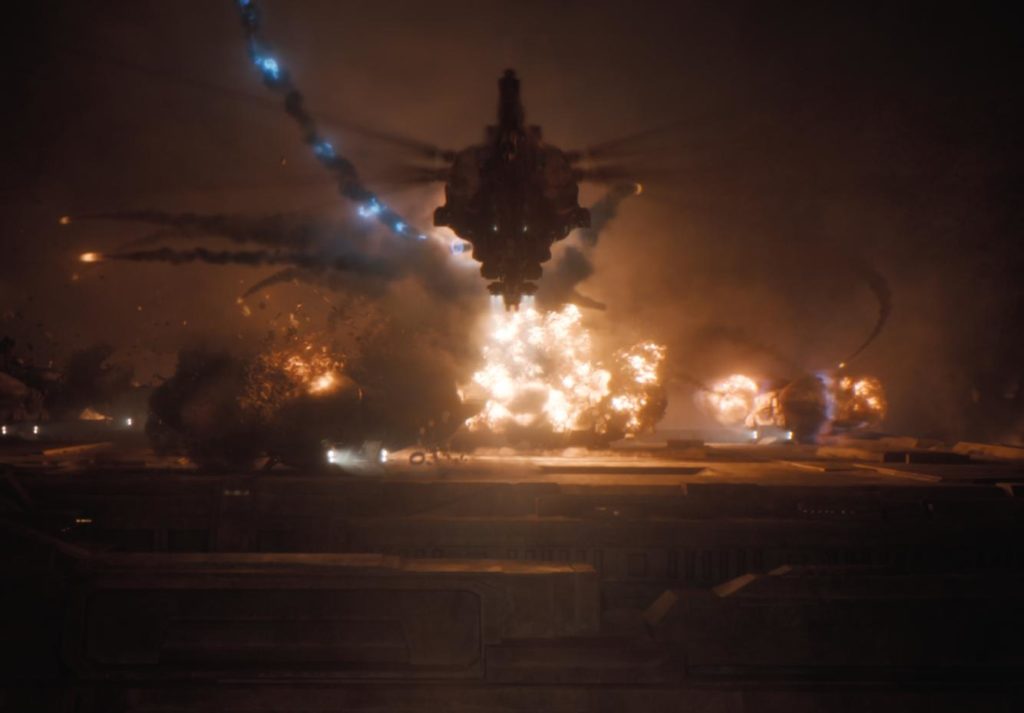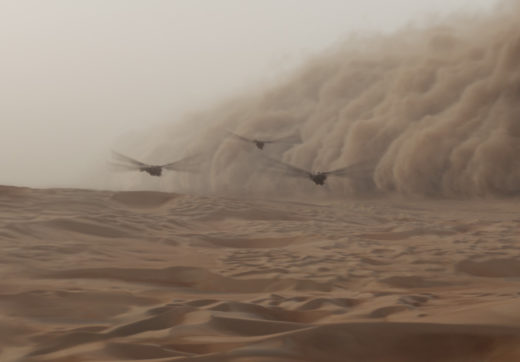
In this episode of Art of the Frame, we interview Brian Connor, a VFX supervisor for DNEG on the newly released Dune. Brian is a veteran in the VFX industry, cutting his teeth at ILM in San Francisco before moving to Singapore to establish an ILM division there. Since then he’s worked with Scanline VFX, Rodeo FX, Digital Domain, and is now supervising at DNEG. Along the way he has been a pivotal part of many of the blockbusters that have graced the screen over the last two decades.
Damian: Welcome, Brian, and it’s great to finally catch up with you after all these years.
Brian: Oh, it’s a pleasure to be here. It’s great to talk to you again, and I’m glad I can be here to just kind of share some of the information of the movie. Denis Villeneuve is, I think just a very, very interesting director in that he’s kind of at the top of his craft, in my opinion.
Damian: I’ve got to say, Dune—to me, the execution was almost flawless. I’m sure I could find some things that were wrong, but I didn’t see them. It’s just an amazing film, the effects are brilliant, but I just think the story’s really well done. I was a fan of the book as a teenager, so now seeing what they did with it, really did it justice. Obviously you guys at DNEG were a huge part of that. Tell me a little bit about what DNEG did and how you guys broke out the work.
Brian: Well, there were two main locations. So there’s DNEG Vancouver, where I worked and lived. I was actually asked by Paul Lambert, who was the visual effects supervisor overall. And some of you might know him because he has the one, two Oscar punch that he won for First Man and Blade Runner 2049. So I worked with him on one of the first projects at DNEG Vancouver when we first started that. So I think because he and I—blood, sweat, and tears, despite all of the trials and tribulations that having or working at a new facility brings with 837 shots that we had in that film—I think we just had a great relationship and we just basically were there, he would be asleep and I would still be chasing up shots (Cause he’s my boss).
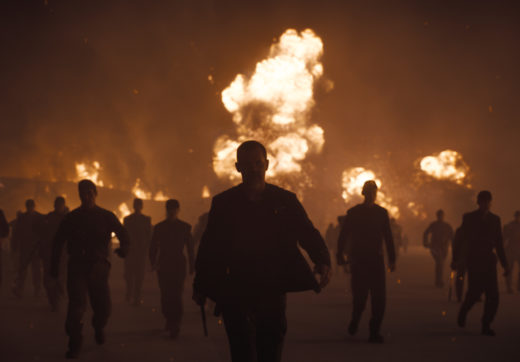 So that’s why he asked me to come to Montreal and head up the work for Dune. And of course there’s no way I could say no to that for obvious reasons, because I also read the book when I was a kid. I used to just read a lot of sci-fi fantasy collections. And so I said, “Yes,” of course, and moved out and I haven’t actually moved back—I just stayed in Montreal. And so, yeah, I’ve been here ever since, but that’s how I kind of got into it with Paul.
So that’s why he asked me to come to Montreal and head up the work for Dune. And of course there’s no way I could say no to that for obvious reasons, because I also read the book when I was a kid. I used to just read a lot of sci-fi fantasy collections. And so I said, “Yes,” of course, and moved out and I haven’t actually moved back—I just stayed in Montreal. And so, yeah, I’ve been here ever since, but that’s how I kind of got into it with Paul.
And then as soon as I got here, I went out to Budapest and joined everybody on the massive stages, which were just…I’ve never seen anything like it. You know, one of the things that, that I’ll be talking about really is just the reason why I think things look believable is because a lot of it is built. They had a budget to where Denis and Patrice and their beautiful concepts that they’ve got from some of the best people all over the world…They knew exactly what they wanted and they built it. And they literally did the same with visual effects. They say, “We want you to build this, but in CG. But it has to look as good as this concept painting,” which—they looked amazing.
I mean, just the attention to detail. There’s going to be a coffee table book that comes out that you can purchase (that I will as well). In fact, I think they have the $600 version that’s signed by Patrice and Denis, if you have that extra cash to spend. But it’s all grounded in reality. And oftentimes [we] were doing set extensions for a lot of the interior work, but they captured, they built every craft.
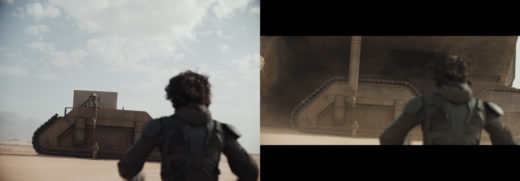
So the ornithopters, just everything that you could possibly think of—except obviously the spice harvester; they build just a track because it’s so huge and part of the whole—but whenever they could, they always had something practical. And that includes the guys in SFX that were always whipping up sand in everybody’s faces. You know, cause it’s a movie about the spice, obviously.
And if we had to do an ornithopter landing, like on the cliff, we did that in Montreal. The one that they always show in the trailers…they landed a helicopter first and we studied that kind of roll and all of the particulate dust, and we didn’t use it as an element—because we couldn’t. If we could, we’d always use stuff that was real practical effects on set, and we would augment it where we had to and we’d learn and just watch what that did and use it as reference.
And Paul was very, very good at saying, “Brian, just match that. Just do that. And I will approve it.” When it came to the sand storm (that we also did in Montreal), the huge sand storms. We’ve seen those in the Sahara desert in Africa and even there’s footage that I found of sand storms just devouring the entire city of Denver.
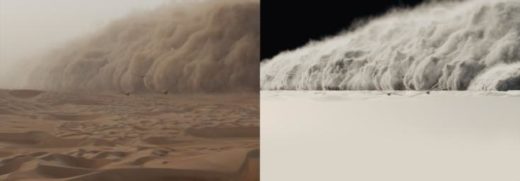
They’re massive and what they look like from the outside and what they look like from the inside and what they look like from the top are all completely different things. And that’s how we treated that sequence when Paul and Jessica are in their ornithopters being chased by the Harkonnens.
That look…some of it’s almost from national geographic and that was our guide. They don’t really move that much from the outside. They’re huge. So getting that sense of scale and basically having just, uh, a lot of reference of real stuff, that was always Paul’s edict. He was always either finding it himself, like, for example, when the planets—and sorry, I’m jumping all over the place—but on Caladan planet where the Atreides flagship is coming out of the water and what that looks like and displacing billions of particles in our simulations…And we have the ocean surface and then you have the water coming off of it, and all of that took a lot of time to do. But it looked right in my opinion, because Paul made us put a six-foot man in a boat next to it. So that when our effects artists—who are amazing—would work on that shot, you could always tell when like, okay, a piece of spray is tall as a building, because I can see it relative to this six-foot man.
So always keeping things grounded in reality was the edict and the key, I think, to the look of everything that we did on that show .
Damian: I’ve actually got a question on the ornithopter crash. When you went down to one wing, I’m curious: How did you guys figure out how the plane should behave with one wing missing?
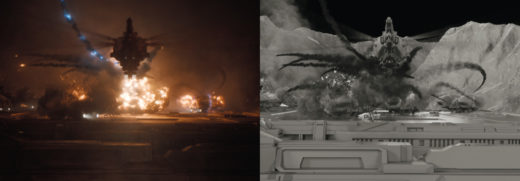 Brian: Well, obviously we had done some previs, so things like that we would show Denis and he would react. And it’s like, sometimes you make something that is because that’s what the director wants. And it’s a stylistic kind of approach because I think if you lose a wing, then you’re going to go down pretty quickly and you’re going to tumble because you have one wing and not another kind of thing.
Brian: Well, obviously we had done some previs, so things like that we would show Denis and he would react. And it’s like, sometimes you make something that is because that’s what the director wants. And it’s a stylistic kind of approach because I think if you lose a wing, then you’re going to go down pretty quickly and you’re going to tumble because you have one wing and not another kind of thing.
Right. So that was just kind of…“stylistic choice” that got us to the ground.
Damian: I imagine not a lot of YouTube references of one wing planes flying so…
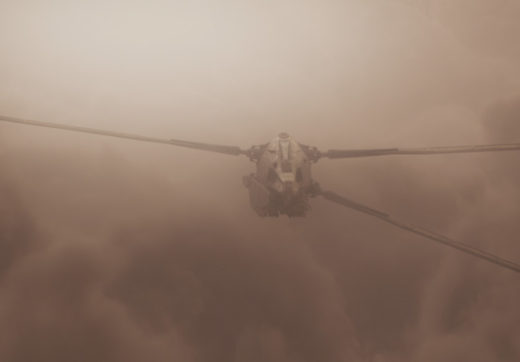 Brian: Well, it was less of a plane was more like a dragon fly. And I’m not saying it was like a, what is it? What do they say? A one-legged man butt kicking contest.
Brian: Well, it was less of a plane was more like a dragon fly. And I’m not saying it was like a, what is it? What do they say? A one-legged man butt kicking contest.
Damian: I don’t know if you’re allowed to say that anymore, but sure.
Brian: Yeah. Um, I’m just trying to, obviously it just doesn’t work well to just have one and you’re trying to fly…
Damian: I was impressed that it didn’t pull me out—It was plausible.
So let’s jump in and talk about the sand. ‘Cause obviously that’s a huge part of the film. This whole planet’s a desert planet. And I’ve got to say that I was really impressed. Usually when I see CG sand it kind of has that “Houdini” look. Nothing against Houdini—because it’s an amazing app—but people have typically used the Vellum solver or some other solver and it has a certain look to it. Whereas this felt incredibly organic. It also had that feeling of ocean waves, especially when the worm was surfing past, but it didn’t take away from the fact that it was sand.
So talk about the process a little bit, if you can, of how you guys came about getting that working.
Brian: Well, the good thing is we went to Jordan. And in Jordan, obviously there’s just the most amazing sandscapes that you can now see in many different movies actually.
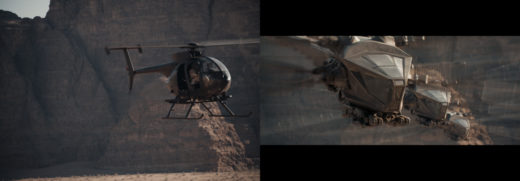
And so we shot real sand dunes and a lot of photography from helicopters. And we had a large assortment of US military helicopters too, that were almost the same size. A Blackhawk is almost the same size as an ornithopter. So we would basically shoot that and it would do the performance and we’d have it land.
And as my partner in crime, likes to say, you “copy and paste in another.” A different vehicle into the shot. And as they say, “Bob’s your uncle.” When you can keep as much of the real stuff as possible…And then learn from what it’s doing and put it back on top. You’re just so winning all the time.
So we tried to replicate the desert. We modeled it and based it on real desert weather. And some of them [dunes] have these interesting tips at the top that I hadn’t seen before. But the main thing is just scale and size. And so when you’re trying to sell to the scale of these massive volumes and the massive size of the sand worms and how much they displace the surface and below it, and all of that kind of stuff…they had to come up with a special system to accommodate that kind of simulation of sand effects.
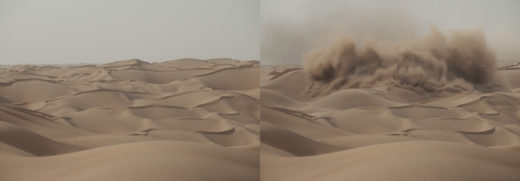
And then there was the rendering of it, which is not an easy task to do, even if you have as many processors as we do. And of course—as anybody who’s worked with big Houdini simulations knows—that takes up a lot of disk space too, to store that.
There wasn’t a lot of footage where you see displaced sand. Obviously we shot some of the sand stuff. When you see our characters interacting, when the worm’s coming…We have these huge “shakers,”—they build them actually for people who think you can lose weight just by standing as they shake you around…
We made a super large one…they constructed and buried it under the sand and then would play with the frequency to get that right look of shock waves from the sand moving. And we found that when you have a specific frequency then people start to sink. So when you see those scenes, that actually is just real sand tuned to a specific frequency where it starts to sink.
So a lot of that stuff, we shot lots and lots of reference. We had the guys from our effects team on set that would help us really capture that in camera as much as possible. And then obviously it’s a matter of extending it in a way that is believable. But luckily for us, we didn’t really have a lot of worm shots.
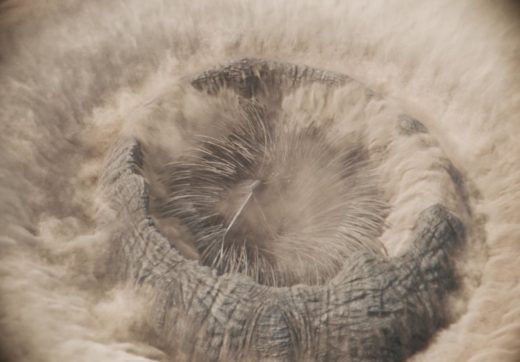 They were in there throughout the movie, but in general, Denis was treating it more like an homage to Jaws. It’s like da-nah, da-nah…You see the [worm] sign, you see it’s coming, you see it displacing a lot of sand. And when they encounter it—Duke Leto and Paul—when they go to where they’re mining the spice, there’s obviously, the vibrations causes the sand worms to come and pounce, and then it ends up swallowing the whole harvester vehicle. All of that is not that many shots, really. I think really they’re saving a lot of that for the second part which, now that we kind of have an approach to it…Obviously like anything else, the first one’s the hard one, figuring it out, but the next time it comes along, you have some efficiencies that you can use to then leverage versus making it up.
They were in there throughout the movie, but in general, Denis was treating it more like an homage to Jaws. It’s like da-nah, da-nah…You see the [worm] sign, you see it’s coming, you see it displacing a lot of sand. And when they encounter it—Duke Leto and Paul—when they go to where they’re mining the spice, there’s obviously, the vibrations causes the sand worms to come and pounce, and then it ends up swallowing the whole harvester vehicle. All of that is not that many shots, really. I think really they’re saving a lot of that for the second part which, now that we kind of have an approach to it…Obviously like anything else, the first one’s the hard one, figuring it out, but the next time it comes along, you have some efficiencies that you can use to then leverage versus making it up.
Damian: I’ve got to say, the size of the budget is impressive for half a movie, or half a story, without the studios committing to the second movie right away. Obviously I think COVID was a factor there. If COVID hadn’t shown up, this thing probably would have just exploded at the box office.
I would have been very disappointed if I’d initially seen it on HBO and not at the cinema, because it’s just that epic of a movie. It really is a little bit of an injustice to watch on a small screen.
Brian: Oh, absolutely. I mean, it’s not just the picture, but it’s the sound. The sound was incredible. That was meticulously crafted. And one thing—probably a silver lining of the pandemic. Which by the way, we’d finished the movie. The last, I don’t know, I want to say 25% when we were almost at the end, we all had to go home and we all had to grab our monitors and anything that we could carry from the office—literally, and just go home and then work from home.
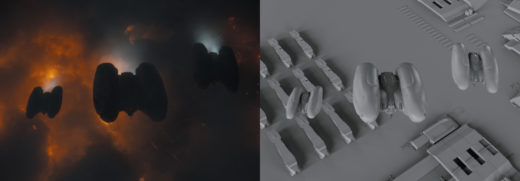 It was just that sudden. So it’s a testament to everybody that worked on it, that we were able to get through the massive change of not being in dailies and talking as a group and looking at shots together to just being at home alone, where I was running my sessions and I didn’t have editorial anymore.
It was just that sudden. So it’s a testament to everybody that worked on it, that we were able to get through the massive change of not being in dailies and talking as a group and looking at shots together to just being at home alone, where I was running my sessions and I didn’t have editorial anymore.
And all of these things that you take for granted, of course, until you’re having to supervise artists working from home. So there’s a lot of bumps and things that you have to work out along the way that we were still able to deliver.
Damian: Let’s talk about the practical sets, because that’s obviously one of the real hallmarks here is that a lot of this stuff really was built.
Brian: A lot of it is in camera with SFX off-screen blowing sand and wind for the actors and things to make them, uh, cinematic. I mean, we did have set extensions to do, and all of a hurricane—the city itself was a massive undertaking. That was a huge amount of detail that you could literally fly around and put a camera anywhere you wanted.
And that the attention to detail, even in the bevel work and the sand that would collect naturally, if it was blowing for real…All of that kind of stuff was stimulated, and then once it rested, we’d just freeze it there. But in the introduction, when we go from the spaceport to Arrakeen and we fly over the city, that was all obviously computer graphics.
And that undertaking was just exhaustively detailed because again, we kept referencing these amazing concepts that Denis and Paul would point to. And we would match to the point where you could literally A/B between the concept and our finished 3d textured, lit effects model and environment. And of course adding atmospherics and whatnot.
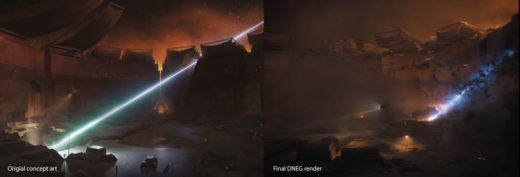
Damian: As a visual effects artist, I had a hard time picking where the practical left off and the CG started. I think that’s one of the most impressive things of the whole venture.
Brian: You know, obviously a testament to Denis and the production designer.
And of course my boss, Paul Lambert. He is very good at getting things built for real…Just enough to match into. Of course we have all of the data of where the lights were and what lens were used and…
Damian: And all the LIDAR you need from the set, right?
Brian: Yeah, exactly. We took LIDAR profusely—probably too much. So we have it in case we need to build sets or add an extra scene or…make another movie. We have that data, but because we built it and we knew where the lights were, the quality of the light, and we had a lot of just…information.
We had something to match into, not flawlessly, of course—it’s never perfect—but as close as you can get in the time that you have. And we actually finished the movie in time for a December release of last year. And because of COVID—I think most people know—it was pushed and then pushed again.
Damian: Did anything get played with in the interim or did it just sit on the shelf?
Brian: Well, I think they had some reshoots and they added a couple of scenes. Just to kind of help flush out the story. And then I think Denis spent a lot of time with the sound, which again is a reason to see it theatrically. He spent a lot of time and just the almost imperceptible aura and atmosphere of what that place feels like playing with all those great things that you can do with sound these days.
If you have it at home, I mean, I spend the money for good quality television and surround sound. But even that being said, it’s not the same because you’re on your couch and you can check your phone and you can go, you know, get something to eat. And then it’s like,
Damian: And you probably don’t have 30 to 40 speakers surrounding your room.
Brian: Exactly. I do have subwoofers, but they have, especially in an IMAX theater
Everything was shot for IMAX. We rendered everything that way as well. So if you see it in 2.35, you’re kind of missing out on some of the fun top and bottom.
Cause IMAX is more of an almost square format. So there’s a lot more imagery. For those of you who want to see it again I definitely recommend the IMAX version.
Damian: So the 2.35 was a crop of the IMAX, rather than the other way round?
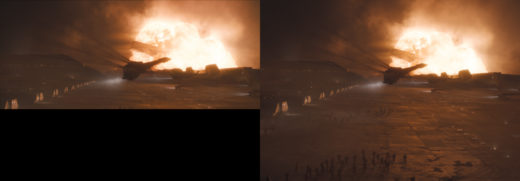
Brian: Correct. There’s a lot more fun to be had. And [for some shots] they wanted the resolution of IMAX, so we had to make these mega frames. We had to add on either side to make a 2.35 crop [in addition to the IMAX render]. So we had to render even larger, just so that we weren’t just chopping the 2.35 out of a IMAX frame.
Damian: Let’s jump back to the sets and just how big some of them were.
Brian: We almost took over an entire studio in Origo, Budapest. It’s so massive. And yet when I first arrived there, well, they took me on a tour and we went from one super massive stage to the next. And I was just…I couldn’t believe that they built all of everything you see in the interior shots.
It was so overwhelming, but I could see how, as an actor, you don’t really have to try to pretend to immerse yourself in an environment if it’s completely all around you. I think just working against a blue screen, I think it’s not very easy to emote and to pretend that you’re in this fantastical world, when it hasn’t even been figured out yet.
And so you’re just using your imagination. But I think there’s something to be said with having real sets that you can touch and interact with and immerse yourself in. So yeah, there were just so many of them. I think the biggest thing though really was the backlot, and that was the spaceport.
I don’t even know what the square meters/square feet of it is. I can just say it’s the biggest thing I’ve ever seen that they built for a movie. The side was probably 20-30 foot walls all around it. They were kind of angled so that they would catch sun. And everything was painted in sand color.
And actually one of the things that we came up with was the process of using not a blue screen, but what we call the “sand screen.” So we have these 40 x’s, and we’d move these massive sand screens into place where we needed them, like if we had some closeup footage or coverage that we needed to do.
And one of the interesting things that I found was no one cared when I would ask to move the sand screen around, not like they would a blue screen. I think there are a lot of directors and actors that as soon as they see a blue screen, they’re just annoyed, you know? And to be fair, they’re quite distracting if you’re trying to make a movie and you’re trying to pretend that you’re somewhere else.
Whereas I found that when you have a sand screen and you ask, “Can I put four [sand screens] in a row?” or even stack them.
They’re like, “Okay, how long is it going to take?
I’m like “15 minutes,” even though it might take more.
But then they’re like, “Okay, fine.” And [the sand screen] just melts into the rest of the ground and to what’s going on. You just don’t even notice that it’s there really. It’s quite amazing in terms of like how people treat you as a visual effects professional. Oftentimes they were like, “This is so much better than blue screen.” They thought that was the bee’s knees, because it turns out that when you pull the key, it doesn’t have to be blue. It doesn’t have to be green, doesn’t have to be red.
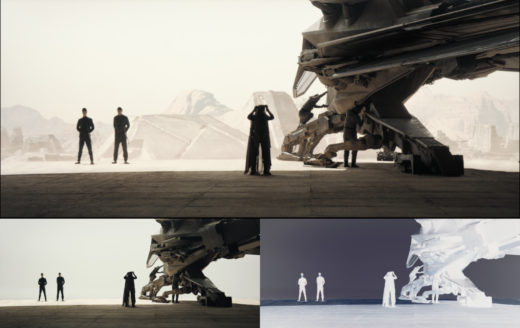
It can be whatever kind of solid color that works best for the separation between the background and the foreground. As I know, you’ve written many, many books. So ours was sand screen color, and all you would have to do is just invert the image and automatically the sand screen would turn into blue and you have your edges and you do your extraction.
And yes, the density of it wasn’t perfect for the core, but I really don’t care about that as much. Cause we can order roto pretty easily, right? But what we can’t do is roto hair and all of the little wonderful, subtle detail that you have in edges. So that’s where the sand screen and that technique comes in.
Damian: That’s really interesting. So basically it was an inverted blue, to some degree, and then you obviously get the right kind of spill.
Brian: Yeah, correct. No blue spill, that we’d have to extract. If someone does that too hard, or has their sledgehammer out instead of their scalpel, then you can get some things that look odd and you don’t know why, especially in reflections and things.
So with this [sand screen], we were able to keep everything. And that’s another reason I think why our foreground blended into our background so well is because we’re not messing with it.
Damian: Right. One of the big problems with sci-fi in general comes because the scenes are so abstract. It is all blue screen or green screen. It’s often very hard for the artist to really know where to put things like lighting.
I always find that artists way overdue things like lightwrap. And everyone looks like they’re glowing in sci-fi movies like this, like somehow there’s a supernova happening behind them or something. And this sand screen and because you had so much practical on everything else, it really didn’t suffer from those things.
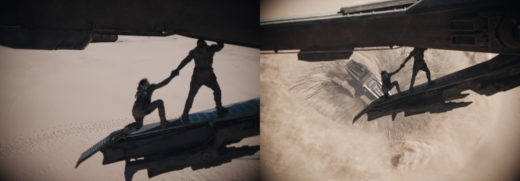
Brian:The thing is, the teams that we had everywhere, our team and Vancouver, the team in Montreal, the team in Mumbai, everybody really put their heart and soul into this movie and really cared.
When we’re saying, “These edges are not there. These edges are not there.” They were like, “Okay, I’ll keep doing it until you’re happy. And I don’t care, because I want it to look good as well.” I think across the board, everybody was just so very much happy to be on the production and to contribute to what was going to be a difficult task.
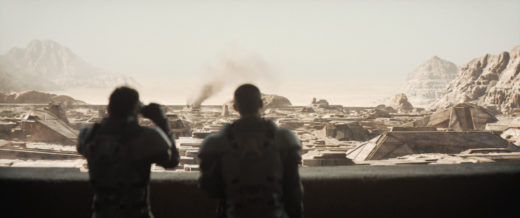 It’s like, how do you remake a movie and have it be different? And have it look better than what was previously done? You’re always up against a novel and piece of work that was done before. So you’re always having to make sure that you’re leveling up and adding to what was done before. It was a really enjoyable process.
It’s like, how do you remake a movie and have it be different? And have it look better than what was previously done? You’re always up against a novel and piece of work that was done before. So you’re always having to make sure that you’re leveling up and adding to what was done before. It was a really enjoyable process.
Damian: What was your favorite sequence to work on?
Brian: Well, for me—I know it sounds a bit underwhelming—but that whole Atreides arrival, when the gates open up and we see the control tower in the background and this huge, desolate place with the sand always blowing. And as they’re walking through, you have these massive ships with all of the [practical] crowds and CG crowds and dust and all of that pomp and circumstance, until they finally go in and check out the sand containers and that area.
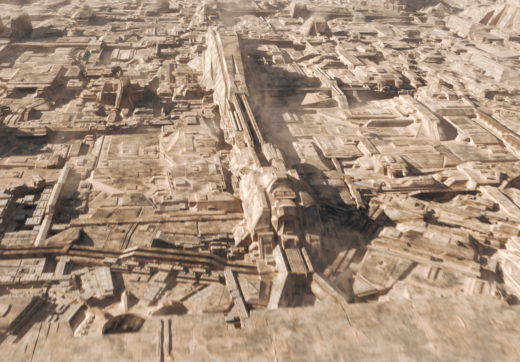
There’s also the sand harvesters, how they move things around and where they’re working on them and trying to make them work. All of those locations, all in one…It was just such a difficult, yet wonderful establishing of this world that I think is very, very important in terms of setting the tone of what the movie is going to be like and setting a sense of realism.
It’s not easy to do that in a big desolate space. It turns out there’s a lot of extra gack and things that you have to build and put in there and stuff on the ground. And just everywhere you can possibly think.
Damian: You have a fairly limited color palette, I guess, right? To really make things stand out?
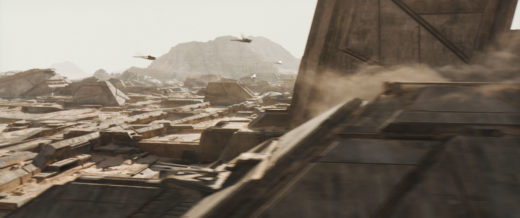 Brian: Yeah, exactly. Any kind of subtle details and textures, you see them right away. So you have to use them precisely and exactly, but yeah. Everything to do with that whole Atreides arrival and establishing the sheer scale and the scope of it, which is not easy to do, it takes some time to do.
Brian: Yeah, exactly. Any kind of subtle details and textures, you see them right away. So you have to use them precisely and exactly, but yeah. Everything to do with that whole Atreides arrival and establishing the sheer scale and the scope of it, which is not easy to do, it takes some time to do.
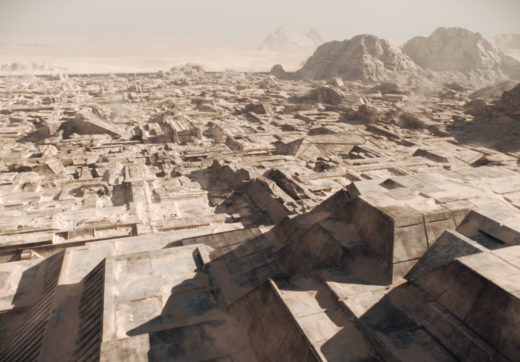 And then of course, Duncan Idaho landing, and all of that whole scene is just really nice. It came together very, very nicely and I’m very proud of the work that we did particularly—a lot of that stuff that we did in Montreal. And then we gave all of this carefully crafted stuff to our friends in Vancouver, who “upres’d” it, for lack of a better word.
And then of course, Duncan Idaho landing, and all of that whole scene is just really nice. It came together very, very nicely and I’m very proud of the work that we did particularly—a lot of that stuff that we did in Montreal. And then we gave all of this carefully crafted stuff to our friends in Vancouver, who “upres’d” it, for lack of a better word.
Damian: Was all of the destruction CG, or were there some practical?
Brian: Yeah, no, absolutely practical. In fact, early in the show, our SFX guy. Gerd [Nefzer] and his team, they blew up a lot of things and we shot them and then we analyzed them and we copied them exactly in FX, down to the pixel. So we had those available and ready to augment and place where needed.
But like I was saying before, Denis and the whole team, they like doing things for real. So, I mean, they blew a lot of stuff up. Believe me, they set things really on fire and just, it was a, yeah, there were just a lot of special effects in there as well to help us marry in everything that we were adding to this.
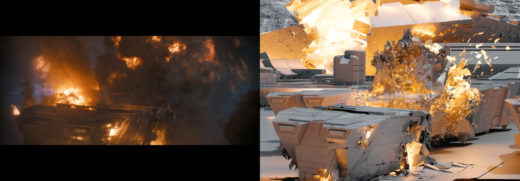
Damian: Very cool. So you did the departure from Caladan, right? Tell me about the water effects and getting all that work.
Brian: Oh, I mean, yes, the flagship, rising up? Now that took a while. I mean, those kinds of shots that are going to take a while, there’s going to be some R&D; it’s a slow burn shot.
You budget and you schedule it so that it’s running in the background, off to the side, for a lot of the show. And that’s what we did. Cause you have to give it the love that it deserves—if you want something that big to look good. And again, as I mentioned, just having the right scale and examples.
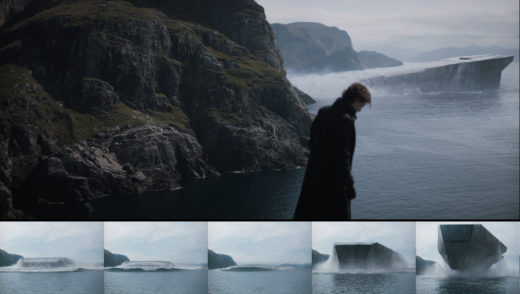
One of the examples Paul found was because of all the global warming that’s going on, we have chunks, super massive chunks of icebergs breaking off the main ice sheet. And sometimes they roll and some of them are as big as the Eiffel tower, if not larger. And so they’re rolling as they break off. And as the top is going down, the bottom is coming up and all of the water that it displaces and how it cascades off of the top and the sides? We studied ad nauseum, just to make sure that we had that scale right. Because it’s so hard to get that right.
The first ones out of the gate are pretty fast, but then once you start getting into the minutiae, it just takes time to do. And luckily on this show we had the time we needed to make it look great.
But then that whole theme with the Bene Gesserit ship, we built that as well. There was a partial set piece and they had tons and tons of atmospherics and stuff going on, but we had it when it didn’t have atmospherics and we shot all sorts of reference and we knew where the lights were.
We basically added to it with our effects team, exactly replicating what was going on on-set with the practical elements and atmospherics. We can then put our stuff in and add a bunch of things like rain and then the ground as well.
And then anything with moving parts obviously is us. Of course, when it’s super dark, you’re working a stop or two up anyways, so you can make sure all of the details are there. And then if you’re watching it on grandma’s TV, nothing pops, right? But yeah, it’s a great blend of visual effects and special effects.
We definitely couldn’t do it without them [special effects], because if anything, they give us the best reference you can have.
Damian: Did you guys have many prosthetic effects or beauty work to do on the show?
Brian: No, not really. It’s mostly prosthetics. Although there were a few things that we’ve added. We had to take out or add here and there as usual.
Obviously we have the personal force fields that they could turn on and off. Coming up with that effect…that was mostly kind of a comp gag where you use before and after frames and you blend them together in an interesting way to achieve that force field look.
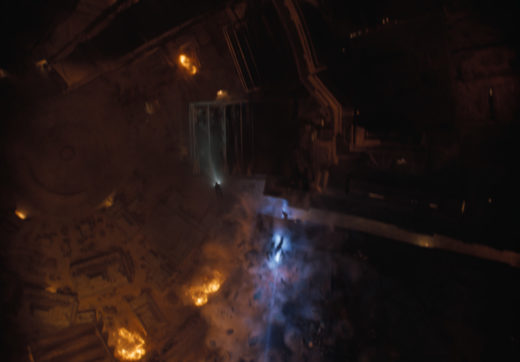
Originally the color was not there. It used to be a lot more subtle, the version that we had, but then it was decided that people couldn’t really see them as well, especially in fights. And so then it became like, “Okay, when you strike something, it’s going to be blue. But if you strike something slowly and drill in—like with a knife—it’s going to start to turn red, and then you’ll be able to penetrate that personal shield.” Right? And we use that same kind of language to add to the attack on the spaceport and Arrakeen.
Damian: It definitely helped sell the story and the flow of it. And certainly more subtle than the 1984 version.
Brian: Oh yeah. I’m sure somebody, 10 years from now, or 20 years from now, will be laughing at us as, cause we did it manually where…
Damian: Well back in 1984 that was cutting edge CG.
Brian: Yeah, I mean, of course people were wowed by that as well. They had never seen something like that.
Damian: A lot of negativity about that first Dune [1984]. I personally liked it. Maybe because I was a teenager at the time.
Brian: Of course. That’s the thing, right? It’s subjective. And I grew up at the same time as well and have seen it [the 1984 version] multiple times, including back when we had the DVDs and we watched the extra footage and we heard the director commentary and all of that—how they shot it and built all of those models and miniatures and bigatures, if you will—because they were huge, some of the ships—and how they would lens it and get it all in frame.
And just with visual old-school optical tricks. Quite impressive feats. And for the time, even the worms, like they didn’t think those were going to work, but yet when you slowed it way down and you put it in context, it kind of works. So you do the best you have with what you have at the time, I guess.
Damian: Yeah. No, it was, it was definitely a feat. And maybe the biggest criticism is just trying to squeeze that book into one movie. And I think it was a good choice to split the new movie. I’m bummed that I have to wait a couple of years, but it was a good choice.
Brian: I agree wholeheartedly because I couldn’t imagine trying to fit in the whole book again into two and a half hours, three hours. Actually, when I saw it with all of my peers—we had a DNEG screening—and I was so surprised when the last scene came up and I was like, “Oh my God, I know this scene. And this is at the end.” And like, we’re done. It was one of the first times where two and a half hours in I was like, “Wait a minute. Where did the time go?” And of course, to me, that’s a good thing. You’re just completely immersed in the story and the visuals, and then it’s done. It’s like, “Wow, I want to see the next one.” So I’m very glad that a lot of people have that same reaction and hopefully I’ll be working on the next one.
Damian: it’s officially Greenland now, right? So that’s good. Now we just have to wait. Now like pretty much every big studios—even small studios—you guys actually have an outfit in Mumbai.
Brian: Yeah, I mean, we have to Chennai, of course there’s London and I think we’re opening up a new one in Toronto.
So they’re always expanding and yeah, when we work with our team in Mumbai, I think the hardest thing really is just the time difference. The rest of it we can figure out in terms of bringing people up to speed and sharing the knowledge and the things that we’ve learned. And that just takes time like anything else.
You get out what you put into it, which is why I always made sure that when we were working with Vancouver as well, it’s the same thing. Trying to over-communicate and if anything starts to go sideways, I’m just like, “Let’s just get on a call and talk,” and we can look at each other and have a conversation.
Damian: How does the work breakout, how do you tend to share shots and data between the different locations?
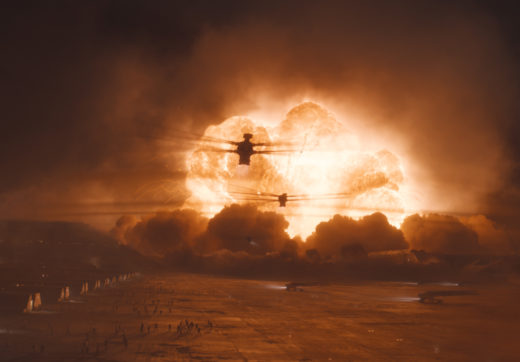 Brian: Well, we try to do it by sequence if possible. Cause there’s kind of clear delineations between the different sequences. Sometimes it is location or environment-based as well. So if we have something at the hangar cavern where Paul and Jessica are running away from the Sardaukar at Kynes’ house and they get in the older ornithopter—it’s not the same as the rest, there were three different kinds—but they get in that and they take off and then that’s when they hide in the sand storm. But it just kind of depends on what makes sense. Again, usually it’s sequence based, but there’s always crossover.
Brian: Well, we try to do it by sequence if possible. Cause there’s kind of clear delineations between the different sequences. Sometimes it is location or environment-based as well. So if we have something at the hangar cavern where Paul and Jessica are running away from the Sardaukar at Kynes’ house and they get in the older ornithopter—it’s not the same as the rest, there were three different kinds—but they get in that and they take off and then that’s when they hide in the sand storm. But it just kind of depends on what makes sense. Again, usually it’s sequence based, but there’s always crossover.
And in terms of assets, we’re always sharing those amongst each other and making improvements on things and changing things to what benefits or what we need for the shots.
Damian: I want to switch gears a little bit and just talk more about the VFX industry as a whole, because obviously you’ve been in the thick of it.
You started out and made a name for yourself at ILM. You went from there to ILM, Singapore, right? To help start it up, and then you’ve obviously branched out from there. But can you tell me a little bit about how you made your career jumps from different locations? Because you really have been all over.
Brian: Yeah, back in the day when I was at ILM, everybody to my left was as good or better than me and everybody to my right was as good as better than me. So why do I deserve a promotion? Why do I get to be a lead or a comp supe? I went from 3d to 2d mostly because I found I could fix all of my 3d mistakes and errors there—and make it look better too.
And then I just kinda…didn’t go back. To go up in a company where you have so many great people, so many talented people, you have to work harder and sacrifice sometimes and move to a different location. So that’s what I decided to do with my buddy Nigel. And we went there [Singapore] and it was just him and me, and it was a production team.
We made something from nothing, which was probably one of the hardest things I think I’ve ever done. But anything that’s difficult in life, you learn a lot more from than the easy things—I find. Same thing with people; the people that have really given me a hard time in my life, I actually try to take something out of it that I can learn from.
Because a lot of times with any situation, it takes two to tango. And that’s why now when I go into a situation where I’m on set and I have the showrunners and I have maybe a line producer that’s yelling and a lot and people that just apparently don’t like me, because I’m visual effects, maybe? If I’m wielding a blue screen, they’re just like, “Oh,…” You know?
Damian: As VFX supervisors, we are often profoundly despised. It’s because you’re the one holding up the expensive actors, moving blue screens around, doing all the annoying things, when the camera op already thinks they have the shot, right? It’s not a real popular job on set when it comes down to it.
Brian: It’s not, but what I was getting to is like, I go into every situation and I just assume I don’t have all the information because in reality, I don’t. And so, as long as you kind of try to be compassionate.
Know that they’re angry, but they’re coming from…maybe they didn’t get any sleep. Maybe some personal issues that I don’t know about. That’s why they’re cranky, but usually they’re actually okay. So I try to just give people some space and take things with a grain of salt and not personally. Because I know I can win them over with some good dad jokes and maybe a drink or two.
Damian: I think that’s wisdom. That’s one of the biggest problems I think in general, is if anyone comes onto a set with an ego, it just doesn’t go well.
Brian: It doesn’t go over well.
Damian: Unless you’re the director and you’ve got five major films behind you. Then you’re allowed to have the ego. But for the rest of us, having an ego really does not extend your career.
Brian: Well, and maybe you’ve earned it. And so therefore a sec…It’s never easy initially for anybody, I don’t think—very rarely anyway. So you have to just kind of pay your dues and work through it and don’t expect it to be spoonfed or that someone’s just going to plop it on your lap.
You always have to chase it and what you want. I think, deciding that you want to do something sometimes…the someone else, they see you down there and like, “Hey, why don’t you come on up here? The view is much nicer.” Once in a while, you’ll get a helping hand. I remember when you and I were working on the Encyclopedia of Visual Effects—to bring up the past—I really rode on your shoulders on that one.
And you did all the heavy lifting and I was there for the moral support and coming along for the ride, but you really took it. And it kind of taught me that I need to do that myself. And when I work on projects by myself, when you don’t have that support that you have, say at ILM—that you take for granted—once you go out and represent visual effects on set, you have to.
Be very mindful of the different personalities that are in front of you and be very strategic and careful on how you talk to those people and treat the people and try to ingratiate yourself into the group. And that just takes time because no one’s going to like anybody off the bat, doesn’t matter who you are.
Damian: On the other hand, you also have responsibility to retake the shot. If something went wrong and you know that it’s not going to work in post. I mean, that’s one of the big problems, isn’t it? Because we can fix it in post, but you’ve got to weigh, “Is it worth making these guys reshoot?
Brian: Right. It’s where you have to think before you talk about the ramifications. You can be certain that the line producer is going to be like, “Wait a minute, hold on. What, what, what does Brian want? What did he say? Why, Brian, why do you need this?” And I’m like, “Well, I need this because if I don’t have that, then I have to do this, this and that and this in post.” Well, okay, that’s fine. But then you multiply that times 50 shots and I’m thinking it’s going to be about 1 million, 1.1… And there was like, “Oh, okay, hold on a second.” Once you put it in financial terms that a line producer can understand…he also understands time.
He’s like, “Okay, okay. You know what? That makes sense. Go ahead.” It’s always a negotiation on set. And in life, really.
Damian: And the film industry—I don’t think this has changed too much—but the budgets are quite distinct, right? Sometimes in the production mindset. It’s like, “Well, that’s not my budget. You’re blowing my budget right now by holding this thing up.” Even though, “Hey, we can burn a hundred grand here on the set, or we could burn 3 million in post. Which one do you want to do?” Often it’s “Let’s burn 3 million in post. Cause it’s not my 3 million,” you know?
Brian: Well, the thing is, that at the end of principal photography, most of the crew goes to the four winds.
They go onto another show and they’re scattered all over the place. And so they don’t really care as much about the ramifications. So making them understand and trying to appeal to the powers that be and knowing who the players are, is very important when you’re on set so that you can help manage those relationships and the people, so that you can go to them when you need to. Making those relationships and building that trust is paramount to that kind of success.
Damian: I want to thank you, Brian for talking and just filling us in a little bit on the VFX process for Dune.
Brian: Oh, my pleasure Damian. It’s really great to talk to you again, and I’m sorry it took so long. But I’m glad that it was this and I can contribute to your audience as well.
The Art of the Frame audio podcast is available on Spotify, Apple Podcasts, Google Podcasts, Anchor and many more platforms. If you like the podcast, make sure to subscribe so you don’t miss future episodes!

Filmtools
Filmmakers go-to destination for pre-production, production & post production equipment!
Shop Now